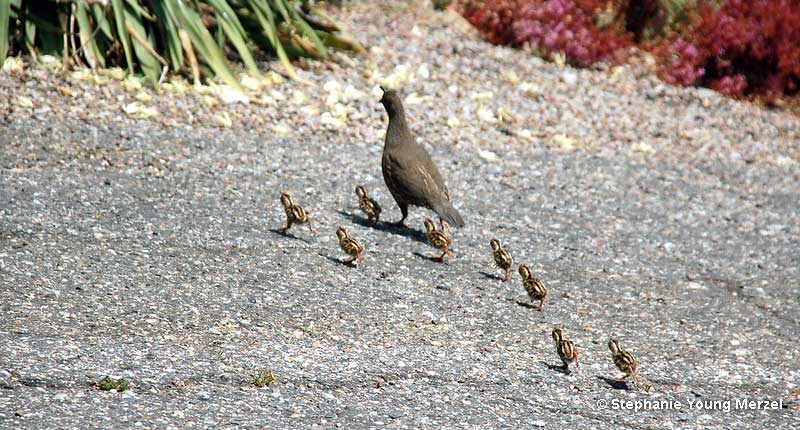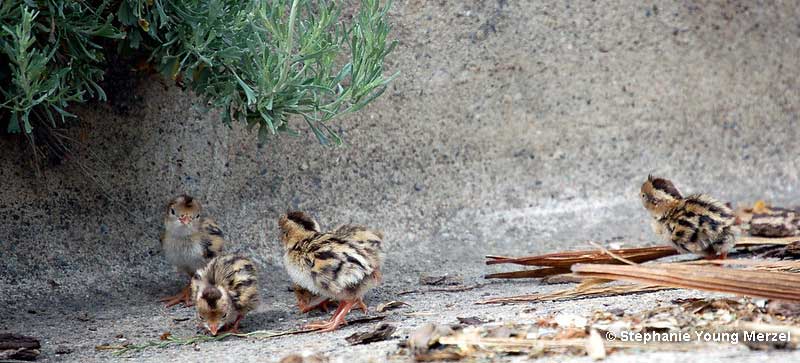
Baby quails are called chicks and are precocial birds. This means they’re hatched in an advanced state that allows them to move around independently and feed themselves almost instantly. They need to be kept in warmer temperatures than most other birds.
Let’s go over everything you need to know about baby quail.
On this page
Nest
Both the male and the female quail will choose the nesting site. The nest will almost always be in low vegetation or on the ground. Nests are usually placed within 65 feet of an opening, such as a road or field.
Both the male and the female will work together to create a scrape in the ground. These scrapes are usually 6 inches wide and 2 inches tall. They’re lined with dead vegetation like grass.
They often weave grasses and weeds into an arch because it helps hide the nest. It takes around 5 days for nests to be built.
Interestingly, the clutch size can range from 7 to 28 eggs, and quails can have 1 to 3 broods per breeding season.
Quail eggs are around 1.2 inches to 1 inch in size and are incubated for 22-24 days. After that, baby quails stay in the nest for one day before adventuring in the wild.
What Does A Baby Quail Look Like?
Quail chicks look like tiny baby chickens. These birds are very small when they first hatch, in fact, they’re the size of bumblebees!
Related: Baby Birds – From Hatching to Adulthood
They have dark brown or black stripes down their backs and have golden tan down feathers.
Baby quail are precocial birds, which means they’re hatched in an advanced state, allowing them to feed themselves and move around independently almost instantly.
They find food on their own, and they need to be kept in warmer temperatures than most other orphaned birds.
How To Tell Baby Quails Apart?
To tell baby quails apart, you can look at their plumage and behavior. First, let’s talk about their plumage. Female birds have light-colored feathers on their breasts. For example, the feathers could be pale brown or cream. These light-colored feathers usually have brown speckles as well.
Related: When do birds start laying eggs?
Male birds have dark-colored breasts. The feathers are typically reddish-brown and don’t have speckles.
Unfortunately, depending on the species of quail, you may not be able to use the pattern and color on the breast to determine its sex.
When it comes to behavior, female and male quails usually have different behaviors, whether it be a common personality, a different behavior towards each over, or varying behaviors during mating season.
Female quails tend to be more calm while male quails are more aggressive towards each other. Male quails are known to attack each over unless they inhabit a large enough space with an abundance of hiding spots.
You can watch quail during the mating season as well. Doing this will tell you who is who because females are the ones to feed the chicks and build the nest. However, there are more reliable methods than this because males can sometimes build the nest as well.
Lastly, you can listen to these birds’ vocalizations. Male quails tend to call to female quails, but sometimes the female will produce a similar call.
Males tend to be more vocal and are louder and call a lot more during mating season. Male quails have even been heard growling during the mating season.
What Do Baby Quails Eat?
Quail chicks eat the same foods as adult quail; they can be picky about what they eat. These birds are granivores, so they primarily consume seeds and grains. However, this doesn’t mean they won’t consume other types of food. They’ve also been known to eat vegetation, worms, and insects.
Different quail species can be found in a wide variety of habitats all around the world in the wild. In fact, there are around 130 distinct quail breeds.
These birds prefer plants that have gone to seed because they enjoy munching on the seeds that have fallen from their stalks. They like to consume foxtail flowers, wild sweet peas, and ragweed.
Related: What do baby birds eat?
If quail haven’t had any food in a while and grains aren’t available, they won’t hesitate to find bushy fruits and nuts like acorns, raspberries, and currants.
Lastly, every now and then, quail will consume some insects. Therefore, people who wish to increase the amount of wild quail in their yard will take sizeable measures to ensure an abundance of insects available. For example, they’ll grow insect-attracting plants or crops in their fields.
Frequently Asked Questions
How long do baby quail stay in nest?
It takes around 3 weeks for quail eggs to hatch. Once the quail chicks hatch, they’re immediately able to move around and leave the nest. The reason why they’re able to move around instantly is that it’s crucial that they get away from the scent that freshly hatched eggs produce. This smell can attract predators like fire ants, snakes, and foxes.
How many quail babies survive?
Baby quails have an estimated mortality rate of 85 percent. Unfortunately, very few chicks make it to adulthood. This is because these birds don’t have the best defense mechanism. Baby quails freeze at the first sign of danger.
Can you keep a baby quail as a pet?
Yes, you can keep baby quails as pets. In fact, these birds make excellent pets! Quails have cute personalities, are easy to care for, and are fun to interact with! Quails primarily stay on the ground, but some species can fly. They don’t require any large coops or cages, rarely bite, and are quieter than chickens.
Are baby quail hard to keep alive?
Baby quails are not hard to keep alive as long as you take the proper precautions. Just be sure to keep them away from other animals. You can place them in a brooder with their mother. The brooder should have plenty of water, plenty of food, and soft bedding for the first 5 weeks.



